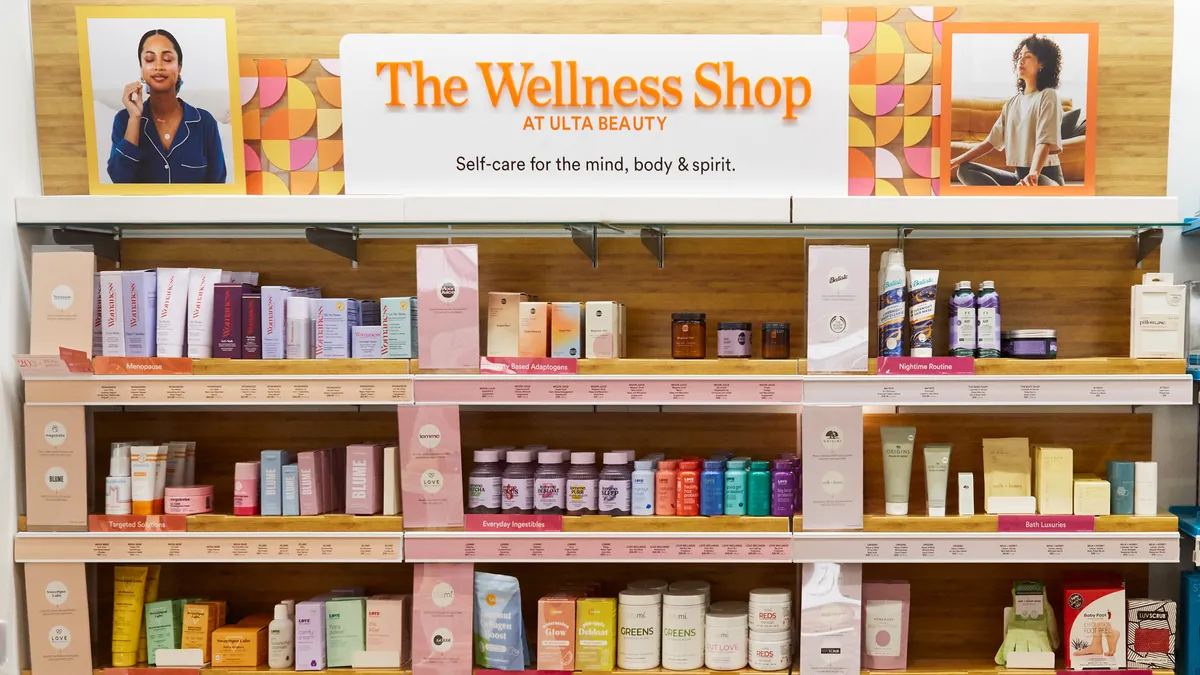The on-again, off-again, maybe-on-again of tariffs that got on retailers' last nerve in 2019 serve as a neat metaphor for the industry as a whole — in retail, things are complicated, swiftly changing and sometimes contradictory.
The U.S. consumer, for example, seems confident, yet remains picky. Stores need e-commerce, yet e-commerce needs stores. It's complicating the business from merchandising to fulfillment, shaking up the c-suite, and landing ill-prepared or debt-heavy retailers in the financial dust.
That 2020 is an election year will only make an already complex environment more bewildering. Here is a look ahead to 10 of the trends Retail Dive is watching most closely.
1. Pure-play retail is less "pure"
We've witnessed the grand entrance of direct-to-consumer brands over the years, but now they're solidly here, introducing the next stage of growth (or reckoning) for digital natives. Some of the most popular direct-to-consumer (DTC) brands achieved unicorn status in 2019, indicating a $1 billion valuation and their status as a hard-to-ignore presence in their markets. At the same time, signs of a DTC shakeout have emerged, with some brands, including Wayfair and Chewy, posting large losses even as sales rise. As these brands grow up, more successful expansion, and risk of failure, are on the horizon.
In their rise, DTC brands have continued to learn from traditional retailers, first by recognizing the potential in e-commerce and now by opening up physical stores to complement it. Brick and mortar is now a key part of their strategies, with footprints that vary from a handful of stores for brands like Everlane, to Casper's plans for 200. In many cases, the brands have come to see brick and mortar as an essential piece of the puzzle, though with very different goals for the spaces than other retail sectors have had during their times of expansion.
In turn, DTC brands have taught pure-play physical retailers that the e-commerce experience is just as essential to their strategy as storefronts are. That's led to a blurring of channels and even stalwart brick-and-mortar retailers like Costco finally building out e-commerce. It's also primed consumers to look directly to brands for product, rather than to the retailers they often sell through. That's perhaps best evidenced by Nike's commitment to its Direct strategy, which came to a head with the November announcement that it would stop selling on Amazon.
2. Executive teams shift
Last year saw the highest number of CEO departures through November since Challenger, Gray & Christmas started tracking the numbers in 2002. The firm's November report recorded that 1,480 CEOs had left their posts up to that point in 2019, 12% more than during the same timeframe the prior year and just four short of the previous full-year record, from 2008.
The departures in retail are happening at a variety of companies, including distressed retailers like Destination Maternity and David's Bridal as well as better-positioned brands like Nike. The retailers that lost CEOs last year include Tapestry, Gap, Under Armour, Best Buy, Away and Bed Bath & Beyond, among others. The C-suite shuffling extends beyond just the top role, with Bed Bath & Beyond and J.C. Penney building up whole teams around new CEOs — and getting rid of those that didn't stack up.
Expectations for the C-suite, and the CEO in particular, have also risen. They must not only keep the ship from sinking, but also bring new ideas to float it ever higher. In some ways, that explains Nike's choice to replace Mark Parker with John Donahoe, a former eBay CEO, given that the brand is looking to build out digital even more. Likewise, J.C. Penney hired Jill Soltau, an executive with a long history of merchandising experience, to solve a slew of problems at the department store, not least a lackluster assortment.
On top of all that, CEOs are being held accountable for bad company culture and other personal transgressions, including undisclosed relationships or otherwise failing to meet company standards. By November, 14 CEOs had left their positions due to professional misconduct, Challenger, Gray & Christmas noted. "Any behavior unbecoming to a company's brand is pretty quickly followed by a resignation announcement," Andrew Challenger, vice president of the firm, said in a statement.
3. The purpose of stores changes
Both direct-to-consumer brands and legacy retailers are re-evaluating the purpose of a store.
Casper in 2018 announced it planned to open 200 stores across North America. Prior to that its foray into physical retail had been through partnerships with Target and West Elm. Warby Parker now has more than 100 stores and Bonobos has more than 60. All told, digitally native brands are set to open 850 stores in the next five years, according to a report from Real Estate firm JLL.
It isn't simply a trend; it's become necessary for survival. Ray Hartjen, marketing director at RetailNext, told Retail Dive in an earlier interview that DTC brands are pressured into opening brick-and-mortar locations because the cost of customer acquisition when operating solely online is so high.
At the same time, legacy players, especially those in malls, are finding it necessary to shrink their store footprints. Store closures in 2019 exceeded 9,000 in the U.S., far surpassing openings, according to Coresight Research.
Nordstrom launched Local, its merchandise-free retail concept, in 2017 and pushed the boundaries of what is considered a store. As consumer habits evolve, companies are searching for ways to evolve their stores to best serve customers' needs.
4. BOPIS packs a punch
While buy online, pick up in-store (BOPIS) services aren't new, they will continue to help the bottom line of those retailers that can deliver on logistics and speed.
This past holiday season shoppers took advantage of BOPIS services in order to save money. Additionally, 49% of consumers stated that in-store pickup is quicker than at-home delivery. That's an advantage when delivery is going through a time of upheaval. In December, for example, Amazon banned third-party sellers from shipping Prime orders with FedEx Ground or Home, citing a "decline in performance." In a move that highlighted those woes, FedEx announced that the company would cut air freight capacity after a 50% margin loss.
BOPIS services may benefit traditional brick-and-mortar retailers, by cutting down on last mile expenses and turning stores into a competitive advantage over online retailers, including Amazon. In a November interview with CNBC, Target CEO Brian Cornell noted that the retailer's costs drop 90% when customers utilized BOPIS.
5. Apparel struggles — except for secondhand
While retail as a whole struggled during 2019, a number of companies that filed Chapter 11 are in the apparel category. Additionally, there are companies that are teetering on the edge with either a high or elevated risk of bankruptcy including Ascena, J. Crew, RTW Retailwinds, Tailored Brands, Express and J. Jill. Department stores are largely in the same boat, too, because they have heavily favored apparel in their product mix in recent decades.
In 1987, the average consumer allocated 5.9% of their spending to apparel, but by 2017 that number had decreased to 3.1%, according to a Deloitte report. A number of factors, including a dressed-down workforce, a shrink in the middle class and increased competition means that retailers are fighting for fewer apparel dollars.
The one part of the industry that may prove to be the segment's saving grace — at least temporarily — is secondhand clothing. Resale has grown 21 times faster than the wider apparel market over the past three years. Secondhand retailer ThredUp recently forged partnerships with more traditional retailers including Macy's, J.C. Penney and Madewell. Additionally, luxury resale company TheRealReal made a splash when it launched an IPO during the summer of 2019. The rise of secondhand apparel comes as Gen Z shoppers have largely refused to pay full price on clothing, citing affordability as their top value when making purchasing decisions.
6. More retailers enter distressed territory
Major retail bankruptcies surged in 2019, surpassing 2018, though not 2017's record numbers. Retail liquidations contributed heavily to a flood of store closures, which according to Coresight Research hit a record of more than 9,000 last year.
There are still plenty of retailers with sagging sales, large debt loads and fragile or deteriorating finances. That's a recipe that raises the risk of bankruptcy. But even retailers that can avoid restructuring will likely still need to shutter a big chunk of their store base.
Mass closures might slow in 2020, but don't expect a sudden halt. Retailers are still overstored. E-commerce penetration is still growing. There is still a price war ongoing among the largest players. As retailers rightsize their footprint, and new retailers grow theirs, equilibrium between store closures and openings is still about five years out, says A.T. Kearney's Michael Brown.
7. Amazon loses its halo
Amazon is one of the most highly valued companies in the world. That probably won't change in 2020, but there is risk that the company's political and legal headaches could start to compound.
In 2019, the company was the subject of numerous stories that alleged it forced third-party sellers to lower their prices against competitors, tailored its algorithm to promote profitability, allowed dangerous products and salvaged goods onto its sites, and rushed to build a delivery network that poses a public safety risk while avoiding legal responsibility for crashes. Privacy issues with the company's voice technology have also been exposed. (Amazon has largely denied such claims or says they represent a small portion of the activity in question.)
Amazon, moreover, is reportedly facing a broad federal antitrust inquiry into its market power. Meanwhile, plaintiffs have challenged whether Amazon can avoid liability over products sold on its site. Brands and retailers, too, have pushed back against Amazon, filing lawsuits over counterfeits and other issues. Others, perhaps most notably Nike, have left the site altogether, deciding they can fare online better without the e-commerce giant's platform. For the company that wants to sell everything on its site, that could be an ominous portent. And the possibility of more unflattering stories pose a potential threat against the company's incredibly valuable brand in 2020.
8. A disappearing middle class impacts retail
While it may seem obvious to note that retailers' fortunes generally depend on the ups and downs of the economy, in recent years in the U.S. that correlation really hasn't been all that hard and fast. Instead of thriving in the post-Great Recession, for example, department stores, malls and others catering to middle-income shoppers have struggled and slid, even amid signs of consumer confidence and other harbingers of economic stability.
That's part of a greater decades-long trend, a stubborn wealth gap in the U.S. that appears to be worsening. In fact, as 2019 trailed to a close, that divide was "the biggest it's ever been," according to Kasey Lobaugh, chief retail innovation officer and omnichannel retail practice leader for Deloitte Consulting. "The winners and losers, if history and trends continue to play themselves out, are a reflection of the continued bifurcation of the consumer and the retail environment," he told Retail Dive in an October interview.
The situation led Kantar to spotlight the "demise of the middle class" as one of its top trends that will bridge the prior decade and carry over into 2020. It "will continue to affect everything from shopper preferences and political leanings to media consumption platforms and the rise and celebration of new 'moments,'" according to a Dec. 19 email to Retail Dive.
In fact, the reality may become even more stark, considering that the economy could take a few dips that are poised to hit the middle class especially hard. Growth in GDP, employment and retail sales is expected to slow in 2020 compared to the past three years, and fundamentals in the housing market, including home sales and prices, are also expected to moderate, according to a Dec. 19 note from Telsey Advisory Group.
Add to that the political uncertainty ushered in by the Presidential campaign itself: "[T]he upcoming US presidential election could create volatility and uncertainty for the financial markets, and distract consumers," Telsey analysts warned.
9. Department stores face a reckoning
The retail model that perhaps thrived best when the middle class thrived — and began a slow, inexorable decline as the middle class faltered — is the department store. Macy's in recent years finished its planned closure of 100 stores, with CEO Jeff Gennette in November strongly hinting there may be more to come. Barneys New York is emerging from bankruptcy as a brand more than a retailer. Sears has all but disappeared. J.C. Penney is struggling.
In fact, in 2019 the segment stood out as deteriorating "the most of all the retail sectors," with discounts increasing to the point where nearly three-quarters of department store merchandise was on sale, according to a Dec. 30 note from Refnitiv emailed to Retail Dive. Despite ongoing consumer confidence, the sector is likely to face further pressure to close stores, according to the Refnitiv StarMine Combined Credit Risk (CCR) model.
But it's not clear that the American consumer has utterly given up on the department store. This past holiday, half of the 189.6 million who shopped during the Thanksgiving through Black Friday weekend visited one. And new retail concepts like Showfields and Neighborhood Goods tout themselves as "the new department store." The question is, can department stores themselves evolve? Nordstrom, for one, with its emphasis on service and experimentation with concepts like its merchandise-free Local shops, seems to believe so.
"Department stores have a tremendous opportunity to redefine who they are," Doug Stephens, author of Doug Stephens, author of "Reengineering Retail: The Future of Selling in a Post-Digital World" (and a consultant to department stores, including Macy's) told Retail Dive in an interview previously. "But they have to stop stuffing every inch of their stores with product. The stores are a mess, the stores are boring, and products are table stakes now. This notion of staging experiences — it should be what department stores are good at."
10. The circular economy expands
From rental services to resale, the circular economy really took hold in 2019. More brands are jumping on the trend, joining apparel services like Rent the Runway and e-commerce platform ThredUp and furniture rental companies like Fernish and Feather.
According to ThredUp's 2019 Resale Report, which cites research from GlobalData, the secondhand market is projected to reach $51 billion by 2023, with $28 billion of that coming from thrift and donations, and $23 billion from resale. Additionally, the secondhand market is expected to grow to nearly 1.5 times that of fast fashion ($64 billion versus $44 billion) by 2028.
The lines between rental, resale and traditional retailers continue to blur. Lord & Taylor in November was acquired by subscription apparel rental service Le Tote. Bloomingdale's formed a partnership with CaaStle to launch "My List," a subscription rental service. Urban Outfitters entered the apparel rental space with Nuuly. Nordstrom in November announced it was expanding its partnership with Rent the Runway. And ThredUp formed partnerships with Macy's, J.C. Penney and Madewell to sell used apparel in stores.
As consumers become more environmentally conscious, adapting a circular model may become particularly viable for retailers. Fifteen percent of Gen Z shoppers said they are dedicated to reducing the amount of waste they create, in addition to reducing their carbon footprints and single-use plastic consumption, according to a 2019 OC&C Strategy Consultants study.





















